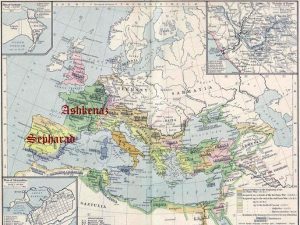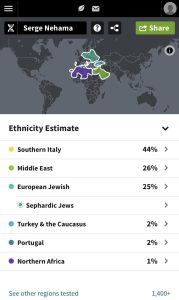Sephardic DNA
 Sephardics are Jews who lived until the end of the 15th century on the territory that is now known as Portugal and Spain. In Hebrew, “Sepharad” means the territory of the Iberian Peninsula. Accordingly, “Sephardim” translates as “inhabitants of Spain”. Today, however, the term has a somewhat broader meaning: it refers to all Jews from the Middle East and North Africa.
Sephardics are Jews who lived until the end of the 15th century on the territory that is now known as Portugal and Spain. In Hebrew, “Sepharad” means the territory of the Iberian Peninsula. Accordingly, “Sephardim” translates as “inhabitants of Spain”. Today, however, the term has a somewhat broader meaning: it refers to all Jews from the Middle East and North Africa.
This group is strikingly different from those who follow Ashkenazi religious and daily traditions. If you suddenly discover an ancestor with a Spanish, Portuguese, Arabic, or even Hebrew surname, it makes sense to dig a little deeper.
Keep on reading, and we’ll tell you what this ethnic class is and how to identify your affiliation to it. We’ll discuss a variety of ways, from researching your family tree with an emphasis on archives to taking DNA tests.
an Israeli citizenship specialist
Historical Background

Ashkenazi and Sephardic Jews
As we have already discovered, Sephardics are the descendants of those Jews who were cited in the Iberian Peninsula long ago. Back in the 10th century, Spanish Jews played a leading role in the spiritual development of the local people. They participated in social and political life and conducted many serious scientific studies. Their opinions were taken into account.
This happened at a time when Spain was a thoroughly Muslim country. After a while, things were not so smooth, however, since an edict had been issued forbidding them to remain in the country. Many were forced to flee. Many then converted to Christianity. Those who concealed their Jewish identity remained in Spain.
And those who fled Spain later became known as Sephardim. Sephardics have three main subgroups:
- Morocco and Algeria Sepharadims.
- Eastern Sephardims from former Ottoman lands.
- Western Sephardims from Amsterdam, London, New York, Jamaica, etc. Italian Jews, the Italkim, were considered honorable, while most others were treated with less respect.
Sephardic Ancestry As is The Case Today

Spanish and Portuguese Jews
The modern definition of Sephardim is much broader: now it is based more on religious observance than anything else. A Sephardi considered to be any Jew who follows traditions and local customs in one way or another. However, sometimes one still finds stratification based on West Asian or North African ancestry.
Regarding traditions, the liturgy differs from that of Ashkenazi Jews in that some parts are said in Ladino. In addition, funeral rites retain elements reminiscent of ancient biblical and Talmudic practices – this is particularly evident during the mourning period. Also, they do not observe special days of remembrance. Finally, Sephardic singing in synagogues has certain oriental overtones, which is particularly noticeable during Yom Kippur.
The Role of DNA Test for Sephardic Ancestry

This question is answered quite clearly by Israeli geneticists. They claim that the key differences lie in the mitochondrial DNA, which is inherited only by daughters from their mothers. That is, in the female line.
Scientists have proven that in Old Testament times, four Jewish women moved to the area of modern Eastern Europe. They and their descendants are the ancestors of the semitic people living in this area today.
Modern equipment allows to reveal the presence of even a minimal percentage of mitochondrial cells carrying information about the existence of kinship with the ancestors.
However, there are two other options:
- Y-DNA – a test of ethnicity by the male line. The idea here is that the Y chromosome is passed down the paternal line without recombination, so the genetic information is essentially the same as that of the ancient male ancestors. Most Sephardics (and also Ashkenazis) descent trace their roots back to a man who lived about 3,000 years ago – the High Priest Aaron.
- Au-DNA/at-DNA (autosomal) – an affordable and popular, yet not very accurate test. It can still tell a lot about a family’s ancestry going back six generations (sometimes even up to ten). Unlike the first two, it can be used by both women and men.
Choosing the Right Test
There are many ways to test your DNA for Sephardic genealogy. For example, sites like 23andMe, MyHeritage, and FamilyTreeDNA are ready to help. Let’s explore each of them in more detail.
23andMe
The pioneer and largest company for tracing the roots. The test you take at 23andMe can determine the approximate areas where your relatives lived from several previous generations. It can even tell where your living relatives stay now, as long as they have also taken a test.
23andMe can also tell you a lot about your physical appearance. The obvious and the not-so-obvious things. The lab will determine your eye color, ear size, whether you have dimples on cheeks, the texture and thickness of your hair, and your tendency to freckle and blister. It will also analyze how well you tolerate caffeine and lactose. And it will tell you if you can expect to go bald (if you’re male).
MyHeritage
MyHeritage is an online platform created in Israel in 2003. It allows you to create family pages, share photos and videos, create your own pedigree chart and find ancestors, and, sure do, perform genealogy tests. The social component and family tree building is still the focus, however.
On the downside, the local subscription is expensive and without it, the search capabilities are severely limited. Although the company claims to be able to identify up to five different variants of Sephardic DNA, it feels.. rather far from the truth. If you’re specifically looking for an ancestry check-up, you’re better off with the aforementioned 23andMe. But you can still find a lot of useful information at MyHeritage. Based in Israel and focused on helping Jews reconnect with their progenitors, the organization has over 16 million records and 60 million family trees. Who knows, maybe you will find something useful here?
FamilyTreeDNA
FamilyTreeDNA has been doing ancestry research for 20 years and claims to be the best in the business. However, they do have plenty of drawbacks. Like, the service is slow sometimes. Also, unfortunately, there is no check-up to analyze health. That’s not a big deal, but its absence is a bit discouraging. Anyways, FamilyTreeDNA works pretty well when it comes to identifying Sephardic groups. The administration states that it diversifies two groups (and tests):
- For people with confirmed ancestry
- For people with suspected ancestry
There are other places and private laboratories, but they do not seem worthy of mention. Many either do not function at all or would simply not be able to cope with identifying members of such a local ethnic origin.
Interpreting Your Results

Example of DNA results
The trouble is that there is only an indirect way to find out if you belong to a Sephardic group. The vast majority of checks will only confirm Ashkenazi Jews (but the result will be 100% right). Other Jewish ethnic groups are more heterogeneous due to extensive intermarriage, so it is difficult to find specific genetic markers.
And there are many such upshots. If you get roughly similar indices (with a predominance of Eastern ethnic groups), this can be interpreted as you being a Sephardic as well. The most important thing is that the results include at least some percentage of Jewish roots. So even if you don’t have proper ancestry shown by this or that test directly, it doesn’t mean you are not engaged in the group.
The Role of Genealogical Research in Tracing the Heritage
While DNA testing follows the path of practical results, genealogical research follows the path of establishing a pattern and restoring a consistent logical chain.
Genealogy Resources
You can find information on the sites mentioned above (MyHeritage is especially helpful because it is a full-fledged social network), but you can also turn to other sources. For example, thematic sites and forums. You can find a lot of interesting things at: sephardicgenealogy.com. Archives with information such as Torrio de Tombo, UK National Archives, Yad Vashem Archives and many others should not be overlooked as well.
The Ethical and Social Aspects of Sephardic DNA Testing
Finding people who are close to you in spirit is always a pleasure. And finding your ancestors is even more gratifying. There are not many Sephardic communities left in the world, so if you suspect that you belong to this community, it makes sense to find it out. What you will do with this information is only up to you. Best of luck!
an Israeli citizenship specialist
